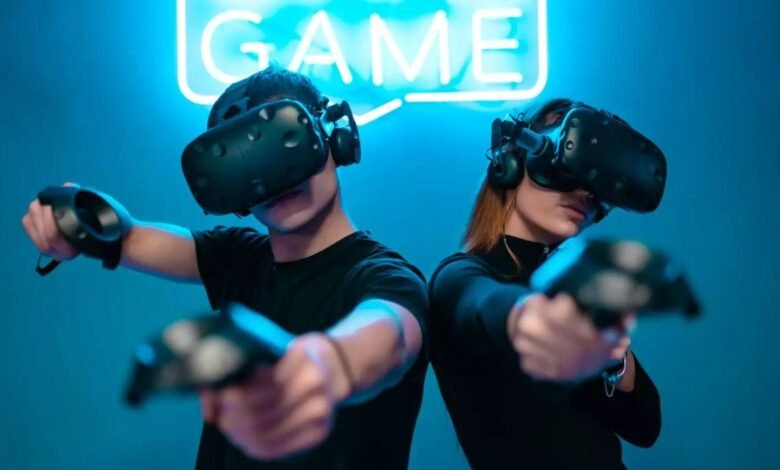How Virtual Reality is Transforming the PC Gaming Experience

Virtual Reality (VR) has rapidly evolved from a niche technology into a transformative force in the gaming industry. What once seemed like science fiction is now a reality that is reshaping the way we experience video games. The PC gaming community, known for its enthusiasm for cutting-edge technology and immersive experiences, has embraced VR with open arms. This article explores how VR is revolutionizing the PC gaming experience, from enhancing immersion and realism to offering new gameplay mechanics and social interactions.
The Evolution of Virtual Reality in PC Gaming
The journey of Virtual Reality in gaming has been a long one, marked by early experiments, technological advancements, and growing consumer interest. In the early days of VR, the technology was often seen as a gimmick, with bulky headsets and limited software support. However, as computing power increased and display technologies improved, VR began to gain traction.
The turning point for VR in PC gaming came with the launch of devices like the Oculus Rift and the HTC Vive. These headsets offered a more refined and accessible VR experience, with high-resolution displays, precise motion tracking, and compatibility with powerful gaming PCs. This combination allowed developers to create more immersive and interactive games, paving the way for VR to become a mainstream component of the gaming landscape.
Immersive Worlds: The Power of Presence
One of the most significant ways that VR is transforming the PC gaming experience is through its ability to create a sense of presence. Presence refers to the feeling of being physically inside the game world, rather than simply observing it on a screen. VR achieves this by immersing the player in a 3D environment that responds to their movements in real-time.
In traditional gaming, players interact with the game world through a monitor and input devices like a keyboard and mouse or a controller. While this setup allows for a high level of control and precision, it also creates a barrier between the player and the game. VR breaks down this barrier by placing the player directly inside the game environment. With a VR headset, players can look around, move their head, and even walk within a virtual space, all of which contribute to a heightened sense of immersion.
The impact of presence is particularly evident in games that rely heavily on atmosphere and exploration. Titles like “Half-Life: Alyx,” “The Walking Dead: Saints & Sinners,” and “No Man’s Sky” have been praised for their ability to transport players to richly detailed and believable worlds. In these games, the player is no longer just a passive observer but an active participant in the game’s narrative and environment. This level of immersion enhances the emotional impact of the game, making moments of tension, excitement, or wonder feel more intense and memorable.
Redefining Gameplay Mechanics
Virtual Reality is not just about making games look more immersive; it is also about changing the way we play. VR introduces new gameplay mechanics that are unique to the medium, offering players experiences that are impossible to replicate on a traditional screen. One of the most significant changes is the use of motion controls and physical interactions.
In VR, players can use their hands to interact with objects, manipulate weapons, and perform complex actions that would otherwise be limited to button presses. This level of interaction adds a layer of realism and engagement to gameplay. For example, in a VR shooter, players can physically aim and shoot their weapons, take cover behind objects, and reload their guns by hand. This creates a more visceral and tactile experience compared to traditional shooters, where these actions are typically reduced to simple button commands.
Beyond shooting games, VR has also expanded the possibilities for other genres. Puzzle games, for instance, benefit greatly from the spatial awareness and hand-based interactions that VR provides. Games like “Superhot VR” and “Keep Talking and Nobody Explodes” challenge players to think and act in three dimensions, creating puzzles that are both mentally and physically engaging.
Moreover, VR has opened the door for entirely new genres of games. “Beat Saber,” a rhythm game where players slash blocks to the beat of music, and “Job Simulator,” a comedic take on mundane tasks, are examples of games that would not work in a traditional gaming format. These games leverage VR’s unique capabilities to create experiences that are both innovative and entertaining.
Social Interaction and Multiplayer in VR
Another area where VR is transforming the PC gaming experience is in the realm of social interaction and multiplayer gaming. Traditional multiplayer games connect players through screens, with communication limited to voice chat or text. While this setup allows for teamwork and competition, it lacks the personal connection of face-to-face interaction.
VR, on the other hand, allows players to meet and interact in virtual spaces as if they were physically present. Avatars in VR can replicate a player’s movements, gestures, and even facial expressions, creating a more lifelike and personal form of communication. This has given rise to VR social platforms like “VRChat” and “Rec Room,” where players can meet, socialize, and participate in various activities together.
In addition to social platforms, VR has also enhanced traditional multiplayer games by making them more immersive and interactive. Games like “Echo VR” and “Population: One” offer competitive multiplayer experiences that are deeply engaging because of the added layer of physicality that VR brings. In these games, players can use their bodies to dodge, aim, and strategize in ways that are not possible with traditional controls.
Furthermore, the sense of presence in VR amplifies the social dynamics of multiplayer gaming. Being able to see other players’ avatars and interact with them in real-time adds a new dimension to teamwork and competition. Whether it’s coordinating a strategy in a VR shooter or collaborating on a puzzle in a cooperative game, the social interactions in VR feel more natural and immersive, leading to a deeper connection between players.
Challenges and Future Prospects
While VR has made significant strides in transforming the PC gaming experience, it is not without its challenges. One of the primary barriers to widespread adoption is the cost of entry. High-quality VR headsets and the powerful PCs required to run them can be expensive, limiting accessibility for many gamers. Additionally, VR can be physically demanding, with some players experiencing discomfort or motion sickness during extended play sessions.
Despite these challenges, the future of VR in PC gaming looks promising. As technology continues to advance, we can expect to see more affordable and comfortable VR headsets, as well as improvements in graphical fidelity and motion tracking. Developers are also likely to continue experimenting with new gameplay mechanics and genres, further expanding the possibilities of what VR can offer.
Moreover, the integration of VR with other emerging technologies, such as augmented reality (AR) and artificial intelligence (AI), could lead to even more immersive and dynamic gaming experiences. For example, AR could allow players to bring virtual elements into their physical environment, while AI could enable more responsive and intelligent virtual characters.
Conclusion
Virtual Reality is undeniably transforming the PC gaming experience, offering players new levels of immersion, interactivity, and social connection. By breaking down the barriers between the player and the game world, VR creates experiences that are more engaging and memorable than traditional gaming. As the technology continues to evolve, it is likely that VR will become an even more integral part of the gaming landscape, offering experiences that are as varied and rich as the imaginations of the developers who create them. The future of PC gaming is not just on the screen; it’s all around us, in the virtual worlds that VR makes possible.



